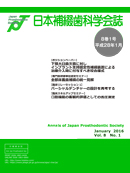Volume 8, Issue 2
April 2016
Displaying 1-21 of 21 articles from this issue
- |<
- <
- 1
- >
- >|
Invited Articles
-
2016Volume 8Issue 2 Pages 113-118
Published: 2016
Released on J-STAGE: May 26, 2016
Download PDF (1454K)
-
2016Volume 8Issue 2 Pages 119-120
Published: 2016
Released on J-STAGE: May 26, 2016
Download PDF (346K) -
2016Volume 8Issue 2 Pages 121-125
Published: 2016
Released on J-STAGE: May 26, 2016
Download PDF (1245K) -
2016Volume 8Issue 2 Pages 126-131
Published: 2016
Released on J-STAGE: May 26, 2016
Download PDF (1535K) -
2016Volume 8Issue 2 Pages 132-137
Published: 2016
Released on J-STAGE: May 26, 2016
Download PDF (745K)
-
Diagnosis and treatment of sleep bruxism: A challenge to link between chairside and bedside findings2016Volume 8Issue 2 Pages 138-139
Published: 2016
Released on J-STAGE: May 26, 2016
Download PDF (387K) -
2016Volume 8Issue 2 Pages 140-144
Published: 2016
Released on J-STAGE: May 26, 2016
Download PDF (649K) -
2016Volume 8Issue 2 Pages 145-152
Published: 2016
Released on J-STAGE: May 26, 2016
Download PDF (1109K) -
2016Volume 8Issue 2 Pages 153-158
Published: 2016
Released on J-STAGE: May 26, 2016
Download PDF (1209K)
-
2016Volume 8Issue 2 Pages 159-160
Published: 2016
Released on J-STAGE: May 26, 2016
Download PDF (357K) -
2016Volume 8Issue 2 Pages 161-166
Published: 2016
Released on J-STAGE: May 26, 2016
Download PDF (782K) -
2016Volume 8Issue 2 Pages 167-172
Published: 2016
Released on J-STAGE: May 26, 2016
Download PDF (1168K) -
2016Volume 8Issue 2 Pages 173-178
Published: 2016
Released on J-STAGE: May 26, 2016
Download PDF (961K) -
2016Volume 8Issue 2 Pages 179-184
Published: 2016
Released on J-STAGE: May 26, 2016
Download PDF (1532K)
Invited Article
-
2016Volume 8Issue 2 Pages 185-191
Published: 2016
Released on J-STAGE: May 26, 2016
Download PDF (1168K)
Original Article
-
2016Volume 8Issue 2 Pages 192-199
Published: 2016
Released on J-STAGE: May 26, 2016
Download PDF (881K)
Technical Procedure
-
2016Volume 8Issue 2 Pages 200-205
Published: 2016
Released on J-STAGE: May 26, 2016
Download PDF (877K)
Case Reports (Specialist)
-
2016Volume 8Issue 2 Pages 206-209
Published: 2016
Released on J-STAGE: May 26, 2016
Download PDF (727K) -
2016Volume 8Issue 2 Pages 210-213
Published: 2016
Released on J-STAGE: May 26, 2016
Download PDF (883K) -
2016Volume 8Issue 2 Pages 214-217
Published: 2016
Released on J-STAGE: May 26, 2016
Download PDF (820K) -
2016Volume 8Issue 2 Pages 218-221
Published: 2016
Released on J-STAGE: May 26, 2016
Download PDF (804K)
- |<
- <
- 1
- >
- >|
